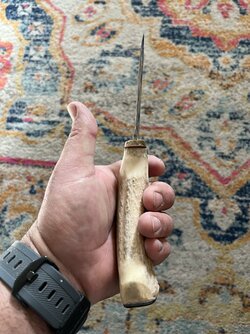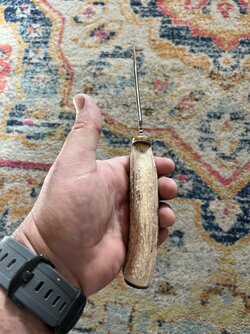- Thread starter
- #261
First test of some Penrhiw Welsh stone found by @cotedupy on one of his rambles. It's novaculite, but thankfully not as hard a hard Arkansas or something of that nature. A cement path, SIC, WD paper progression got it flat and smooth.
While the stone feels very fine and smooth to the touch, there were some visual inclusions that had me a little worried, so trial one is with an inexpensive stainless paring knife I don't care about.
The knife was fairly dull from the wife using it to cut rocks, or whatever it is she does, so initially the Penrhiw was doing 9/8th of bugger all. It was to be expected, these stones tend to be on the slow/fine side. I switched to a soft Ark, made the blade kitchen sharp, then moved over to the Penrhiw.
Now we were in the region of where this type of stone shines, and it increased the arm hair shaving level of the knife up about ten points. I haven't done a tomatto test yet, but it is shaving hair like crazy.
Next I guess I will give it a go with a razor. This would be where the stone would be most useful, or putting a crazy laser edge on a pocket knife, etc. And I can't see any damage done to the edge by the inclusions, so I feel a bit more confident.

While the stone feels very fine and smooth to the touch, there were some visual inclusions that had me a little worried, so trial one is with an inexpensive stainless paring knife I don't care about.
The knife was fairly dull from the wife using it to cut rocks, or whatever it is she does, so initially the Penrhiw was doing 9/8th of bugger all. It was to be expected, these stones tend to be on the slow/fine side. I switched to a soft Ark, made the blade kitchen sharp, then moved over to the Penrhiw.
Now we were in the region of where this type of stone shines, and it increased the arm hair shaving level of the knife up about ten points. I haven't done a tomatto test yet, but it is shaving hair like crazy.
Next I guess I will give it a go with a razor. This would be where the stone would be most useful, or putting a crazy laser edge on a pocket knife, etc. And I can't see any damage done to the edge by the inclusions, so I feel a bit more confident.
Last edited:



